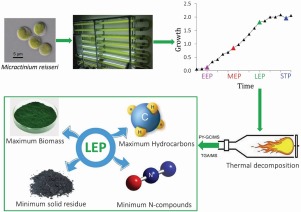当前位置:
X-MOL 学术
›
J. Anal. Appl. Pyrol.
›
论文详情
Our official English website, www.x-mol.net, welcomes your
feedback! (Note: you will need to create a separate account there.)
Characterization and pyrolysis behavior of the green microalga Micractinium conductrix grown in lab-scale tubular photobioreactor using Py-GC/MS and TGA/MS
Journal of Analytical and Applied Pyrolysis ( IF 5.8 ) Pub Date : 2018-10-01 , DOI: 10.1016/j.jaap.2018.08.019 Shuang Wang , Benjamin Bernard Uzoejinwa , Abd El-Fatah Abomohra , Qian Wang , Zhixia He , Yongqiang Feng , Bo Zhang , Chi-Wai Hui
Journal of Analytical and Applied Pyrolysis ( IF 5.8 ) Pub Date : 2018-10-01 , DOI: 10.1016/j.jaap.2018.08.019 Shuang Wang , Benjamin Bernard Uzoejinwa , Abd El-Fatah Abomohra , Qian Wang , Zhixia He , Yongqiang Feng , Bo Zhang , Chi-Wai Hui

|
Abstract Nowadays, microalgae are widely discussed as a promising feedstock for biofuel production. For higher crude bio-oil yield with good quality, microalgal biomass productivity and bio-oil characteristics are essential parameters. However, the same microalgal species has different chemical compositions at different growth phases. Therefore, the present study aimed to identify the best growth phase for high biomass productivity and optimal bio-oil production from the green microalga Micractinium conductrix via Py-GC/MS and TGA/MS analysis. M. conductrix was grown in a tubular photobioreactor and harvested at early exponential phase (EEP), middle exponential phase (MEP), late exponential phase (LEP) and stationary phase (STP). LEP showed the maximum significant (P ≤ 0.05) biomass productivity of 0.058 ± 0.004 g L−1 d-1, with maximum significant lipid and carbohydrate contents (28.7 ± 1.1 and 42.9 ± 1.2%dw, respectively). TGA/MS results confirmed that biomass harvested at MEP and LEP showed higher extent of conversion or mass loss reaction via thermal degradation with the lowest residual solid products. In addition, the hydrocarbon fragments in gaseous products (H2, C2H6, CH4, C2H4) from TGA/MS analysis were found to be released more abundantly at LEP. Moreover, Py-GC/MS results revealed that thermal decomposition of biomass harvested at LEP resulted in the highest significant relative contents of aliphatic hydrocarbons (41.2%) with lowest nitrogen-containing compounds (6.3%). The present study showed the significant impact of harvest time of microalgae on products characteristics of thermal decomposition and nominated LEP as the optimum growth phase to harvest M. conductrix for upgraded bio-oil production.
中文翻译:

使用 Py-GC/MS 和 TGA/MS 在实验室规模的管式光生物反应器中生长的绿色微藻 Micractinium Conductrix 的表征和热解行为
摘要 如今,微藻作为一种有前途的生物燃料生产原料被广泛讨论。为了获得更高质量的粗生物油产量,微藻生物质生产力和生物油特性是必不可少的参数。然而,相同的微藻物种在不同的生长阶段具有不同的化学成分。因此,本研究旨在通过 Py-GC/MS 和 TGA/MS 分析从绿色微藻 Micractinium Conductrix 中确定高生物质生产力和最佳生物油生产的最佳生长阶段。M. Conductrix 在管状光生物反应器中生长,并在早期指数期 (EEP)、中期指数期 (MEP)、晚期指数期 (LEP) 和固定期 (STP) 收获。LEP 显示最大的显着 (P ≤ 0.05) 生物质生产力为 0.058 ± 0.004 g L−1 d-1,具有最大显着的脂质和碳水化合物含量(分别为 28.7 ± 1.1 和 42.9 ± 1.2%dw)。TGA/MS 结果证实,在 MEP 和 LEP 收获的生物质通过热降解表现出更高程度的转化或质量损失反应,残留固体产物最低。此外,发现来自 TGA/MS 分析的气态产物(H2、C2H6、CH4、C2H4)中的烃碎片在 LEP 中释放得更丰富。此外,Py-GC/MS 结果表明,在 LEP 收获的生物质的热分解导致脂肪烃的显着相对含量最高 (41.2%),含氮化合物最低 (6.3%)。本研究表明微藻的收获时间对热分解产物特性有显着影响,并指定 LEP 作为收获微藻的最佳生长阶段。
更新日期:2018-10-01
中文翻译:

使用 Py-GC/MS 和 TGA/MS 在实验室规模的管式光生物反应器中生长的绿色微藻 Micractinium Conductrix 的表征和热解行为
摘要 如今,微藻作为一种有前途的生物燃料生产原料被广泛讨论。为了获得更高质量的粗生物油产量,微藻生物质生产力和生物油特性是必不可少的参数。然而,相同的微藻物种在不同的生长阶段具有不同的化学成分。因此,本研究旨在通过 Py-GC/MS 和 TGA/MS 分析从绿色微藻 Micractinium Conductrix 中确定高生物质生产力和最佳生物油生产的最佳生长阶段。M. Conductrix 在管状光生物反应器中生长,并在早期指数期 (EEP)、中期指数期 (MEP)、晚期指数期 (LEP) 和固定期 (STP) 收获。LEP 显示最大的显着 (P ≤ 0.05) 生物质生产力为 0.058 ± 0.004 g L−1 d-1,具有最大显着的脂质和碳水化合物含量(分别为 28.7 ± 1.1 和 42.9 ± 1.2%dw)。TGA/MS 结果证实,在 MEP 和 LEP 收获的生物质通过热降解表现出更高程度的转化或质量损失反应,残留固体产物最低。此外,发现来自 TGA/MS 分析的气态产物(H2、C2H6、CH4、C2H4)中的烃碎片在 LEP 中释放得更丰富。此外,Py-GC/MS 结果表明,在 LEP 收获的生物质的热分解导致脂肪烃的显着相对含量最高 (41.2%),含氮化合物最低 (6.3%)。本研究表明微藻的收获时间对热分解产物特性有显着影响,并指定 LEP 作为收获微藻的最佳生长阶段。









































 京公网安备 11010802027423号
京公网安备 11010802027423号